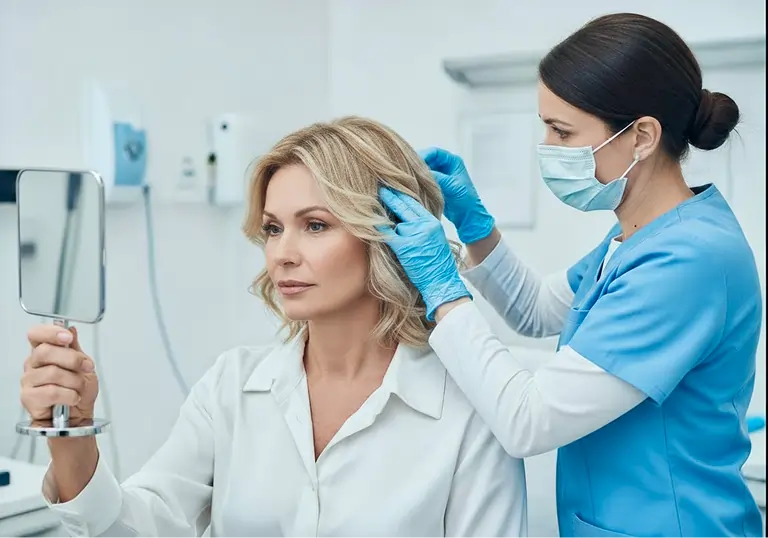For decades, the answer seemed simple – no. Once the follicles were gone, they were gone for good. But science now tells a more hopeful story. Reversing hair loss is not about miracle cures or overnight regrowth. It’s about understanding the biology behind it—and knowing which methods truly work.
In this guide, we debunk the most common myths about reversing hair loss and replace them with evidence-based truths.
Myth #1: Once You’re Bald, You’re Done
This is one of the most persistent beliefs about hair loss – that baldness is final and irreversible.
But the reality is more nuanced. Many hair follicles do not die; they enter a dormant or “sleeping” state.
Recent research from the University of Virginia revealed a stem-cell population in the upper and mid hair follicle essential for regeneration. These stem cells act as a biological switch, deciding whether a follicle grows new hair or remains inactive. When reactivated, they can restart the growth cycle – even after years of inactivity.
This is why regenerative treatments such as PRP therapy, MSC exosomes, and hyperbaric oxygen therapy (HBOT) show promise. They don’t just nourish the scalp; they signal dormant follicles to awaken.
Being bald doesn’t always mean your follicles are gone forever. With modern diagnostics and targeted therapy, some can be brought back to life—primarily if you act early.
Myth #2: Supplements Alone Can Reverse Hair Loss
Walk into any pharmacy and you’ll find dozens of products promising to “reverse” hair loss. While supplements support hair health, they rarely address the root cause.
Hair loss is often hormonal (driven by DHT), inflammatory, or autoimmune. No vitamin alone can reverse those biological processes. That doesn’t mean nutrition isn’t necessary – it absolutely is. Hair relies on adequate protein, iron, zinc, vitamin D, and B vitamins. But these are supportive, not curative.
At Ideal of MeD we often meet patients who have tried every supplement on the market before realizing the missing link was an accurate diagnosis. Through analysis and bloodwork, we can identify the real issue – whether hormonal, nutritional, or structural – and build a plan that works.
Supplements can be part of a healthy foundation, but reversing hair loss requires a medical understanding of why it started in the first place.
Myth #3: More Is Always Better
When something feels urgent – like losing your hair – it’s tempting to try everything at once: every serum, device, and treatment on social media.
But aggressive or mismatched approaches can backfire.
Over-treating the scalp can cause inflammation, irritation, or even damage follicles further. Combining strong products without guidance may disrupt the natural healing process.
Hair restoration is a biological journey, not a race.
A personalized plan based on diagnostics is far more effective than chasing the newest trend. That plan may combine targeted medication (like finasteride or minoxidil), regenerative therapies (PRP, exosomes), and supportive care (scalp health, nutrition, stress control).
At Ideal of MeD, we take a team-based approach where doctors, nurses, and coordinators align each patient’s protocol to their unique hair biology.
Reversing hair loss isn’t about doing more – it’s about doing what’s right for your follicles, in the right sequence and at the right intensity.
Myth #4: All Hair Loss Is the Same
Hair loss looks similar on the surface, but the underlying causes vary dramatically.
There’s androgenetic alopecia (hormonal), telogen effluvium (stress-related), alopecia areata (autoimmune), and scarring alopecias, where inflammation physically destroys follicles.
Each type demands a different strategy.
- Androgenetic alopecia responds best to DHT-blocking medication and regenerative treatments.
- Autoimmune alopecia may require immune-modulating therapies or microneedle drug delivery systems, an area where ongoing research is showing promise.
- Stress-related shedding often resolves once the body rebalances, though supportive care speeds recovery.
Without knowing which type you have, reversing hair loss becomes guesswork.
That’s why diagnostics like TrichoScan imaging and scalp examinations are essential before starting any treatment.
The key to reversing hair loss is knowing which type you have – because only then can you choose the right therapy.
Myth #5: Reversing Hair Loss Means Full Restoration
This myth sets unrealistic expectations. Even with the best science, not every follicle can be revived.
Success often looks like thicker shafts, improved density, and less shedding – not necessarily a teenage hairline.
Hair restoration is a process measured in months, not days. It requires consistent care, follow-up, and maintenance.
The real transformation happens when you stop losing hair, see gradual regrowth, and keep it for years to come.
Reversal doesn’t always mean perfection – it means regaining control, confidence, and long-term stability.
Understanding What Really Works
When you strip away the myths, reversing hair loss becomes a process of precision:
- Diagnose the cause – through medical assessment, imaging, and blood tests.
- Activate dormant follicles – with PRP, exosomes, microneedling, or stem-cell-inspired treatments.
- Optimize scalp health – ensure proper circulation, oxygenation, and cellular repair.
- Support your biology – nutrition, stress control, and hormone balance.
- Maintain – because follicles need ongoing care to stay active.
At Ideal of MeD, every treatment plan starts with understanding the individual – not just the condition. Our diagnostic tools and regenerative methods aim to restore more than hair: they help patients reconnect with themselves.
Frequently Asked Questions
In many cases, yes. True reversal depends on whether your follicles are dormant or permanently destroyed. Dormant follicles can often be reactivated through regenerative therapies such as PRP, exosomes, or microneedling, combined with medical and lifestyle support. Acting early greatly increases your chances of visible, lasting improvement.
You can support hair growth naturally through balanced nutrition, good sleep, stress management, and gentle scalp stimulation. These healthy habits strengthen existing hair and create better conditions for regrowth. However, significant reversal usually requires medical or regenerative treatments that can awaken dormant follicles and restore the natural growth cycle.
Results can last for many years if the underlying cause of hair loss remains controlled and maintenance treatments continue. Once follicles have been reactivated, they tend to stay active with proper care. If treatment is stopped or health factors change, follicles may gradually return to a resting state.
Reversing Hair Loss Begins With Understanding, Not Miracles
Reversing hair loss isn’t about chasing a miracle. It’s about understanding your biology, acting early, and choosing treatments that align with science.
The most important shift happens not on your scalp, but in your mindset – moving from frustration to control.
At Ideal of MeD, we believe transformation starts with knowledge. By separating myth from medicine, we help our patients reclaim not only their hair but also their sense of self.
Because when you recognize the person in the mirror again, you don’t just look better – you feel stronger, brighter, and more alive.




